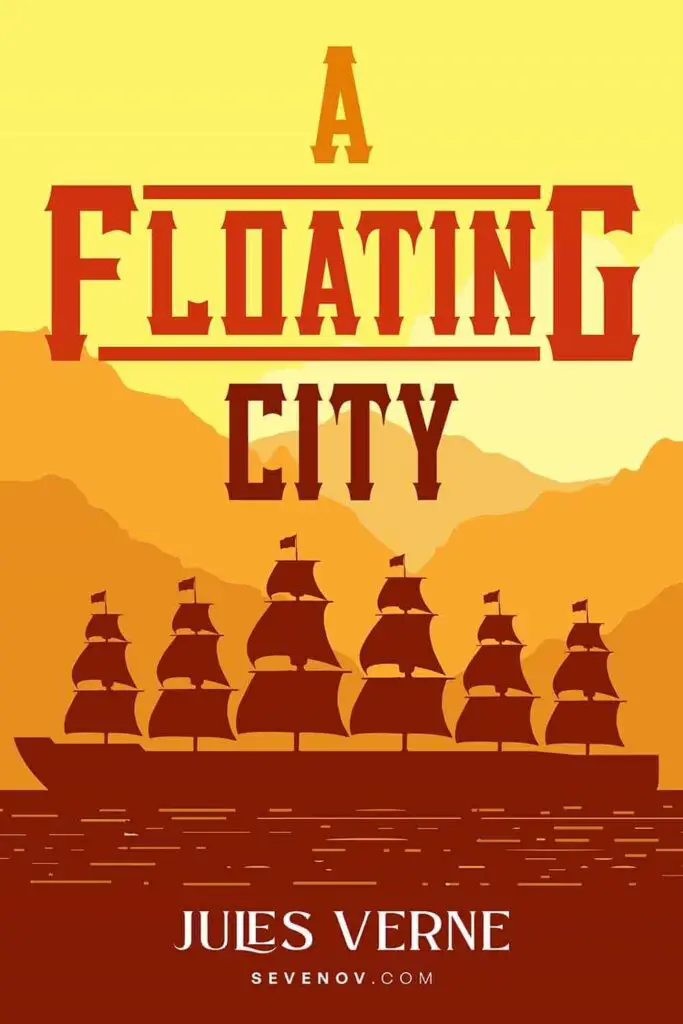
A Floating City by Jules Verne
Author: Jules Verne
Published: 1871
Genre: Adventure
Read A Floating City online at PageVio
A Floating City was published in 1871 by Jules Verne, a celebrated French writer. This adventure novel explores the fascinating concept of a massive steamship that serves as a floating city. It captures readers’ imaginations with its unique setting and engaging storyline.
The narrative follows the journey aboard the ship Great Eastern, which serves as the floating city. In this innovative environment, Verne weaves together elements of technology, human interaction, and suspense. His vivid descriptions and compelling character dynamics bring the floating city to life.
Verne’s ability to blend scientific curiosity with literary finesse makes A Floating City a standout work in his extensive oeuvre. The novel represents a fusion of fiction and speculative genius, showcasing why Verne remains a pivotal figure in literature.
1. A Floating City Summary
A Floating City follows the adventures of a group of passengers aboard the Great Eastern, a massive steamship considered a floating city due to its size and amenities. The story is narrated by an unnamed Frenchman who embarks on the transatlantic voyage from Liverpool to New York.
The novel captures the excitement and marvel of traveling on such a grand vessel, describing its luxurious accommodations, advanced engineering, and the various activities available to passengers. As the journey progresses, the narrator encounters a diverse cast of characters, including the enigmatic Doctor Pitferge, who becomes his close companion.
Throughout the voyage, the passengers experience various challenges and dramatic events, such as severe weather, mechanical failures, and personal conflicts.
2. Creation and Context of ‘A Floating City’
A Floating City was influenced by contemporary events and personal experiences. It was published during a transformative era when technological advancements and historical occurrences shaped Verne’s narrative.
Historical Backdrop and Inspirations
Jules Verne found inspiration following his fascination with technology and maritime innovations. His trip aboard the Great Eastern, a monumental ship of its time, provided firsthand experience that deeply influenced the novel. The ship, designed by Isambard Kingdom Brunel, was a marvel, embodying the era’s industrial prowess.
Verne’s acute attention to these elements lent authenticity and depth to his fictional floating city.
Publishing History and Early Reception
A Floating City was published in 1871 by Pierre-Jules Hetzel. Its release in English through Charles Scribner’s Sons allowed the work to reach a broader audience. The novel quickly garnered attention for its innovative premise and detailed depiction of life aboard a floating metropolis.
Critics of the time noted the book’s unique blend of adventure and technology. The early reception was generally positive, praising Verne’s vivid storytelling and imaginative foresight. The novel’s ability to capture the public’s fascination with technological advances was a testament to Verne’s skill as a writer.
3. Themes and Characters
A Floating City uniquely integrates complex character relationships with themes of technological innovation and adventure. The narrative, set aboard an advanced steamship, unravels the lives and hidden stories of its diverse passengers.
Characters
In A Floating City, key characters include the enigmatic Doctor Pitferge and the unnamed narrator. The story also involves various personal interactions and subplots among the passengers, adding layers of drama and tension to the narrative.
Symbolism and Adventure
The Great Eastern serves as a powerful symbol of human ingenuity and the spirit of exploration. It represents a microcosm of society, disconnected from the traditional constraints of land.
The steamship’s journey is filled with adventure, where passengers confront their fears and desires. Each adventure reveals deeper aspects of human nature, enhancing Verne’s exploration of personal and collective ambitions.
4. Technological Marvels and the Steamship
The steamship itself is a testament to human ingenuity. It signifies progress and the industrial revolution’s impact on travel and society. Verne’s detailed depiction of the ship highlights its advanced engineering and luxury.
The vessel becomes a character in itself, shaping the experiences of all aboard. Its technological marvels serve as a backdrop for the unfolding drama, emphasizing the transformative power of innovation. The history ingrained in the ship’s design underlines the blend of past and future that drives the narrative forward.
| Jules Verne Bibliography | |
| Novels | Five Weeks in a Balloon | Journey to the Center of the Earth | From the Earth to the Moon | The Adventures of Captain Hatteras | In Search of the Castaways | Twenty Thousand Leagues Under the Seas | Around the Moon | A Floating City | The Adventures of Three Englishmen and Three Russians in South Africa | The Fur Country | Around the World in Eighty Days | The Mysterious Island | The Survivors of the Chancellor | Michael Strogoff | Off on a Comet | The Child of the Cavern | Dick Sand, A Captain at Fifteen | The Begum’s Fortune | Tribulations of a Chinaman in China | The Steam House | Eight Hundred Leagues on the Amazon | Godfrey Morgan | The Green Ray | Kéraban the Inflexible | The Vanished Diamond | The Archipelago on Fire | Mathias Sandorf | The Lottery Ticket | Robur the Conqueror | North Against South | The Flight to France | Two Years’ Vacation | Family Without a Name | The Purchase of the North Pole | César Cascabel | Mistress Branican | The Carpathian Castle | Claudius Bombarnac | Foundling Mick | Captain Antifer | Propeller Island | Facing the Flag | Clovis Dardentor | An Antarctic Mystery | The Mighty Orinoco | The Will of an Eccentric | The Castaways of the Flag | The Village in the Treetops | The Sea Serpent | The Kip Brothers | Travel Scholarships | A Drama in Livonia | Master of the World | Invasion of the Sea |




